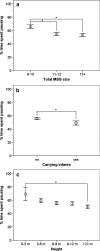Functions of Intermittent Locomotion in Mustached Tamarins (Saguinus mystax)
- PMID: 20949115
- PMCID: PMC2945470
- DOI: 10.1007/s10764-010-9421-7
Functions of Intermittent Locomotion in Mustached Tamarins (Saguinus mystax)
Abstract
Many animals interrupt their moving with brief pauses, which appear to serve several different functions. We examined the function of such intermittent locomotion in wild living mustached tamarins (Saguinus mystax), small arboreal New World primates that form mixed-species groups with saddleback tamarins (Saguinus fuscicollis). We investigated how different environmental and social factors affect pausing during locomotion and used these data to infer the function of this behavior. As measures of intermittent locomotion, we used percentage of time spent pausing and pause rate. We considered 3 possible functions that are not mutually exclusive: increased endurance, route planning, and antipredator vigilance. Mustached tamarins spent on average (mean ± SE) 55.1 ± 1.0% of time pausing, which makes effective resource exploitation more time consuming and needs to be outweighed by correspondingly large benefits. Percentage of time spent pausing decreased in larger mixed-species groups vs. smaller mixed-species groups and decreased with height and in monkeys carrying infants. It was not affected by sex, age, spatial arrangement, or single-species group size. Pause rate increased in individuals traveling independently compared to those traveling in file, but was not affected by other factors. The group size effect in mixed-species groups lends support to the notion that pausing during locomotion is an antipredator tactic that can be reduced in the increased safety of larger groups, but other results suggest that additional functions, particularly route planning, are also of great importance. Benefits in terms of predator confusion and group movement coordination are also likely to play a role and remain a topic for further research.
Figures


References
-
- Avery R. Experimental analysis of lizard pause-travel movement: Pauses increase probability of prey capture. Amphibia-Reptilia. 1993;14(4):423–427. doi: 10.1163/156853893X00110. - DOI
-
- Billat VL, Slawinski J, Bocquet V, Demarle A, Lafitte L, Chassaing P, et al. Intermittent runs at the velocity associated with maximal oxygen uptake enables subjects to remain at maximal oxygen uptake for a longer time than intense but submaximal runs. European Journal of Applied Physiology and Occupational Physiology. 2000;81(3):188–196. doi: 10.1007/s004210050029. - DOI - PubMed
-
- Boinski S, Treves A, Chapman CA. A critical evaluation of the influence of predators on primates: Effects on group travel. In: Boinski S, Garber PA, editors. On the move: How and why animals travel in groups. Chicago: University Chicago Press; 2000. pp. 43–72.
-
- Buchanan-Smith HM, Hardie SM. Tamarin mixed-species groups: An evaluation of a combined captive and field approach. Folia Primatologica. 1997;68(3–5):272–286. doi: 10.1159/000157253. - DOI
LinkOut - more resources
Full Text Sources
Research Materials
